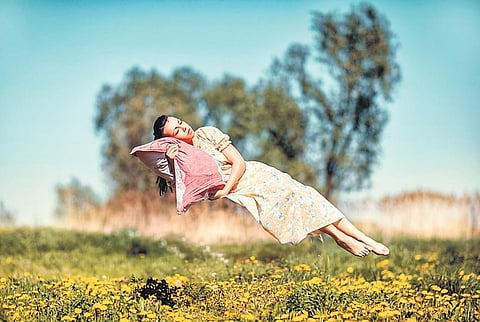

Last year writer Lisa Brace from England dreamt that reality TV personality and entrepreneur Simon Cowell (of American Idol fame) narrated the entire story of a book to her, from beginning to end. “When I woke up, I wrote down everything I could remember… My book Star Survivor based on this, will be published in March,” she says. As strange as this sounds, this ‘dream’ probably occurred when Brace was in hypnagogia—a semi-lucid state between wakefulness and sleep.
Interestingly, nearly 70 per cent of people are known to experience this phenomenon at least once in their lives, as per data published by Cleveland Clinic. While in this transitional state, people experience hallucinatory images, sounds, or most commonly, the feeling of falling through space that leads one to jerk awake. Brace was one of the lucky few who enjoyed the creative benefits of being in this state. In the past, famous personalities such as inventor Thomas Edison and writer Edgar Allan Poe have been known to induce this state of sleep through specific exercises to find creative inspiration.
A 2016 study published in Schizophrenia Bulletin titled What is the Link Between Hallucinations, Dreams, and Hypnagogic-Hypnopompic Experiences?, referred to hypnagogia as a healthy state that most individuals regularly encounter. In many cases, it’s not a cause for serious concern, as the study also noted that 25 to 44 per cent of people simply reported feelings of weightlessness, flying, falling, or feeling the presence of someone else in the room. In some cases, however, it can lead to hallucinations that can severely impair one’s sleep and health.
Homeopathic physician, yoga therapist and hospital administrator, Dr Mandira Adhikari from Delhi, recalls a recent case. At first, she confused the symptoms with narcolepsy, but with continued observation, concluded that the problem was hypnagogia. She prescribed a holistic treatment plan. “We have lots of drugs in homoeopathy for sleep problems,” she says. The nature of homeopathy, however, is that medicines aren’t specific to a single ailment because, “we believe in treating the patient, and not the disease. So, the medicine depends on the overall constitution of the patient.”
To people with hypnagogia, or those looking for better sleep, she recommends the popular Kali Phos to “calm the mind down”, and Passiflora incarnata mother tincture. Dr Adhikari, however, cautions, “You need to consult a doctor for the best treatment.” Yoga postures like the corpse pose or shavasana, standing bent forward or uttanasana, head to knee pose or janu shirsasana and shashankasana can also help alleviate the symptoms. “Guided meditation also helps, whether you have insomnia due to anxiety, or hypertension, or are narcoleptic,” she adds.
To treat a problem in its entirety, one must go to its roots. A young entrepreneur, burnt out from the demands of growing her fledgling business, was unable to get more than three hours of peaceful sleep a night. She would frequently wake up, worried about pending tasks. So, she decided to sign up for the ‘sleep package’ at Six Senses Vana, an exclusive wellness retreat located in Uttarakhand. The dedicated attention she received ranging from a personalised wellness assessment, yoga nidra sessions, acupuncture, massages and meditation helped her enjoy undisturbed sleep. “I feel better than I have in ages, but I hope I can sustain this when I return to Mumbai,” she says
The Schizophrenia Bulletin study findings show that certain people are more prone to experiencing hypnagogia. They usually have low sleep quality and could also suffer from clinical conditions like insomnia, post-trauma stress disorder, depression or anxiety. Alternate treatments such as homoeopathy, ayurveda, acupuncture, reflexology and a focus on movements can help with treatment.
Dr Jayachandran Kunjumpidukkal, the head of Ayurveda and head clinician at Six Senses Vana, sums it up, “Sleep is a biological necessity. Insufficient sleep and untreated issues can create imbalances at the cellular level. This can be a precursor to health problems and can affect our overall well-being, brain function, quality of life, and productivity. In order to develop healthy sleep habits, we must address underlying issues,” he says.
He highlights that their approach to treatment is personalised. It addresses one’s diet, and physical therapies, and if needed, includes the intake of plant extracts and herbal concoctions. “A cleansing procedure like panchakarma performed under careful guidance can also enhance the quality of sleep and reduce the effects of hypnagogia or worse sleep problems,” he concludes.
Enhance the Quality of Sleep
● Use breathing as a tool to connect with your inner self. Deep breathing exercises can help to calm the muscles and nervous system
● Try yoga nidra, which is focused meditation starting from the toes to the head, for deeper relaxation
● Avoid engaging in emotional or mentally taxing conversations before bedtime
● Try and avoid all electronic devices at least one hour before bedtime to facilitate peaceful sleep
● Drink calming teas such as chamomile, lemon balm, brahmi or banana tea to promote a restful night’s sleep